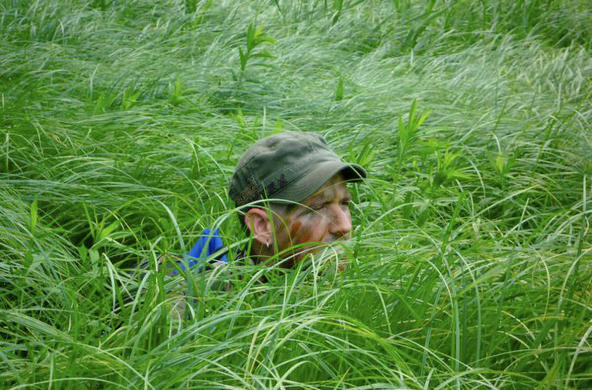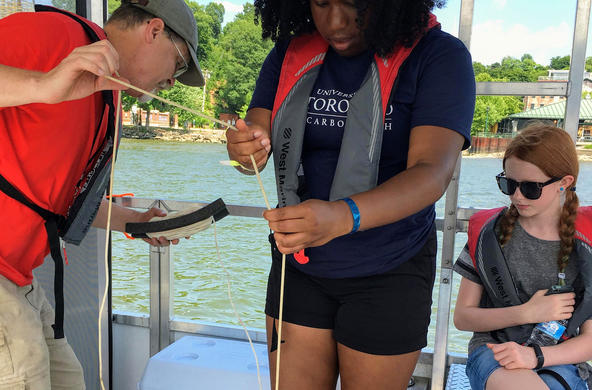In January, IES announced a new era in its 23-year legacy of education. Dubbed the Ecosystem Literacy Initiative (ELI), this new effort aims to help people think about the ecosystems we depend upon and link that understanding to their daily lives.
This is a particularly critical time for launch- ing such an endeavor. Our world is changing in ways that threaten the sustainability of life on earth as we know it, and human activity is a major cause. “This is the first time in history that people have approached this level of global impact,” explains Dr. Alan R. Berkowitz, IES Head of Education and leader of ELI. “A larger percentage of the Earth’s total Clermont State Historic Site resources is being used or compromised by people than ever before. In the past, civilizations have gotten into trouble when they’ve reached similar junctures, when their ability to extract resources essentially outpaced their understanding of its consequences, or their capacity to deal
with such consequences.” Ecologists know that an ecosystem approach– one that forces you to take a careful accounting of everything important in any given place – is essential for addressing the environmental issues facing our world today. But it’s not enough for the scientific community to under- stand this: managers, policy makers, teachers, and citizens must also grasp the concepts of ecosystem function, if society is going to stem the tide of environmental change.
To reach the various target audiences, ELI will employ a multi-faceted approach. The core of the effort will consist of research on how people learn about ecosystems, how educators might teach about them and what kinds of ecosystem literacy various groups of people want and need. The knowledge gained from this research will enable IES to provide useful resources for educators in schools and beyond. ELI also will reach out to policy makers, managers and the general public, giving them the latest and most useful ecosystem information available via the web and other media. Third, ELI will serve to mentor the next generation of ecologists in taking and applying an ecosystem approach.
Why the ecosystem approach is crucial:
People need ecosystems to do things – provide food, clean the water, clean the air, sustain diversity. Many of our environmental problems involve the degradation of such ecosystem func- tions. By embracing the ecosystem approach, we are all better equipped to understand, and hopefully improve, these situations. Dr. Berkowitz offers our production ecosystems – those that produce fiber and food – as examples. “Our society needs these ecosystems to function for the long term. In order for this to happen, we can’t keep treating them as simple systems where all you have to do is plant corn, add fertilizer and wait. There are microbes in the soil, beneficial insects, non-crop plants and fungi, pests that be- come resistant to pesticides and so on. We need to look at these croplands as ecosystems if we are going to learn how to extract what we need from them now, and in the future.”
ELI to help fill an educational gap:
Unfortunately, there is a gap in society’s under- standing of ecosystems. “The word ‘ecosystem’ appears more in national curricula than ‘ecology’, ‘population’ or even ‘evolution,’” notes Dr. Berkowitz. “And yet, people don’t seem to develop a readily useful grasp of the concept.” From understanding their own ecology (their food, water and other inputs, as well the treat- ment of their waste products) to seeing farms or even the entire globe as ecosystems, people have a hard time building real ecosystem “budgets”.
What accounts for this gap?
“Due to their complexity, it’s challenging to teach about and to understand ecosystems,” admits Dr. Berkowitz. “You really need to get beyond textbooks and engage learners in more hands-on study of real world ecosystems.” Furthermore, the evidence that scientists and citizens need in order to understand ecosystems is often long-term and extensive in its scope. “It’s one thing to set up an aquarium in a classroom to study one species of fish,” explains Dr. Berkowitz. “It’s a lot harder to set up a complete ecosystem, and monitor all the components within it over a significant period of time.” Harder still is the challenge to learn to see real places in the real world through this ecosystem “lens”.
To promote a greater knowledge of ecosystems, ELI will have both regional and national dimensions. Programs such as the Ecology Field Programs for school groups and Ecology Day Camps will continue to serve as community re- sources, as well as testing grounds for new educational modules. Teacher workshops and in-class support will enhance the ecosystem literacy of the entire Hudson Valley, while web-based ma- terials will be of interest and use to the general public. Ecosystem-focused events at IES, such as behind-the-scenes tours of the research facilities and symposia applying the ecosystem approach to practical concerns, also are in the works.
The Changing Hudson Project:
One new component of ELI is the Changing Hudson Project (CHP). We all know the river is constantly changing – hourly, daily, season- ally, as well as over years, decades, centuries. The physical and chemical character of the river varies, as do the living things within it. Some changes may be normal parts of the Hudson River ecosystem, while others can lead to sig- nificant, irreversible alterations in its character. Which of these are simply “bends” in the river ecosystem and which are “breaks” – fundamental, long-lasting shifts?
Thanks to a grant from the New York State Department of Environmental Conservation’s Hudson River Estuary Program, CHP will help teachers and students explore this question using real evidence that they collect themselves or obtain from existing scientific studies. A team of practicing teachers, scientists and educators will develop tools to help students visualize the Hudson River ecosystem – both in its unperturbed state and under various forms of disturbance. Using animations, graphics, simulation models and comparative studies, CHP will grow a web-based resource for educators and students throughout the Hudson River Valley. Understanding how changes can impact the biological communities of the river, or the usefulness of the river for drinking water and human recreation, make the study of sci- ence that much more relevant for students.
Since 1983, IES has been untangling the mysteries of ecosystem function while also helping advance the new field of ecology education. The Ecosystem Literacy Initiative will com- bine research and education in a focused effort to help address pressing concerns facing our society. “We now need to bring the concept of ecosystems more squarely into public discourse and into education,” says Dr. Berkowitz. “The needs of the environment, the needs of the educational system and the needs of the public demand nothing less.”






